奈达翻译理论下英文短篇小说翻译策略研究
- 格式:doc
- 大小:18.50 KB
- 文档页数:4
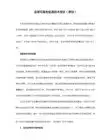
尤金·奈达和他的翻译理论1.奈达翻译理论概述尤金·奈达(Eugene A.Nida)1914年生于美国的俄克勒荷马州。
早年师从当代结构主义语言学大师布龙非尔德(Leonard Bloomfield)等语言学家。
毕业后供职于美国圣经协会,终生从事圣经翻译和翻译理论的研究,著作等身,是公认的当代翻译理论的主要奠基人。
他理论的核心思想是“功能对等”(functional equivalence)。
这个名称的前身是“灵活对等”(dynamic equivalence)。
后来为避免被人误解,改成功能对等。
简单讲,功能对等就是要让译文和原文在语言的功能上对等,而不是在语言的形式上对应。
要取得功能对等(奈达指的对等是大致的对等),就必须弄清何为功能对等。
他把功能分成九类①[在From One Language to Another中,奈达将语言的功能分成9类,即表现功能(expressive)、认识功能(cognitive)、人际功能(interpersonal)、信息功能(informative)、祈使功能(imperative)、行为功能(performative)、情感功能(emotive)、审美功能(aesthetic)和自我解释功能(metalingual)。
见该书第25页。
]译文应在这些功能上与原作对等。
那么,怎样才算对等呢?奈达认为回答这个问题不能只局限在文字本身,他把判断对等与否的大权交给了读者的心理反应。
这就与在奈达之前大多数翻译研究者的观点相左。
传统上,人们总是将客观的语篇作为判断译文对错优劣的依据。
但奈达一下子把大权从语篇手中抢过来,交给了读者。
这一转手马上创出了一个崭新的局面,为当时几乎陷入绝境的翻译研究者打开了眼界,西方翻译理论研究一下子柳暗花明。
奈达这一发展当然是和他本人对翻译的研究有关。
但奈达并非闭门造车,功能对等自有其源头活水。
这活水就是当时语言学领域突飞猛进的发展。
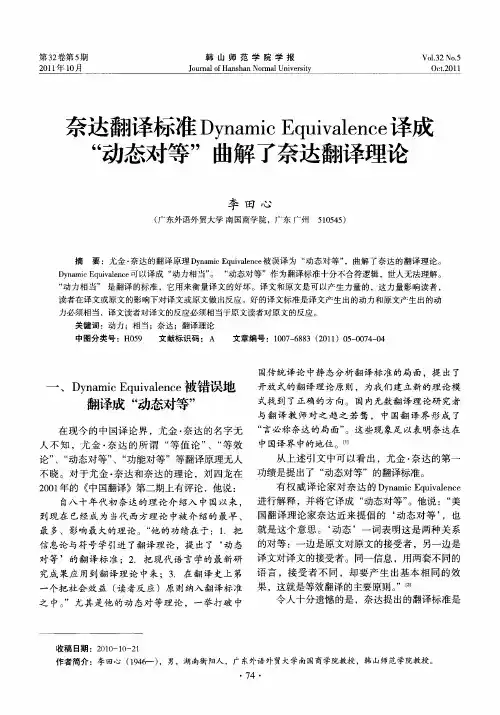

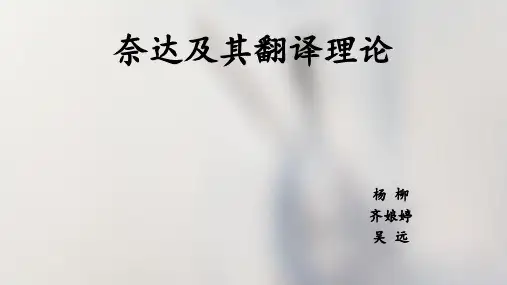
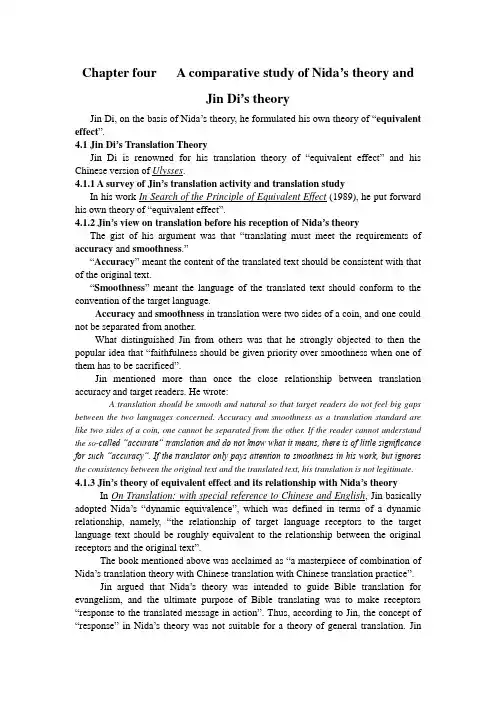
Chapter four A comparative study of Nida’s theory andJin Di’s theoryJin Di, on the basis of Nida‟s theory, he formulated his own theory of “equivalent effect”.4.1 Jin Di’s Translation TheoryJin Di is renowned for his translation theory of “equivalent effect”and his Chinese version of Ulysses.4.1.1 A survey of Jin’s translation activity and translation studyIn his work In Search of the Principle of Equivalent Effect (1989), he put forward his own theory of “equivalent effect”.4.1.2 Jin’s view on translation before his reception of Nida’s theoryThe gist of his argument was that “translating must meet the requirements of accuracy and smoothness.”“Accuracy” meant the content of the translated text should be consistent with that of the original text.“Smoothness”meant the language of the translated text should conform to the convention of the target language.Accuracy and smoothness in translation were two sides of a coin, and one could not be separated from another.What distinguished Jin from others was that he strongly objected to then the popular idea that “faithfulness should be given priority over smoothness when one of them has to be sacrificed”.Jin mentioned more than once the close relationship between translation accuracy and target readers. He wrote:A translation should be smooth and natural so that target readers do not feel big gaps between the two languages concerned. Accuracy and smoothness as a translation standard are like two sides of a coin, one cannot be separated from the other. If the reader cannot understand the so-called “accurate” translation and do not know what it means, there is of little significance for such “accuracy”. If the translator only pays attention to smoothness in his work, but ignores the consistency between the original text and the translated text, his translation is not legitimate.4.1.3 Jin’s theory of equivalent effect and its relationship with Nida’s theoryIn On Translation: with special reference to Chinese and English, Jin basically adopted Nida‟s “dynamic equivalence”, which was defined in terms of a dynamic relationship, namely, “the relationship of target language receptors to the target language text should be roughly equivalent to the relationship between the original receptors and the original text”.The book mentioned above was acclaimed as “a masterpiece of combination of Nida‟s translation theory with Chinese translation with Chinese translation practice”.Jin argued that Nida‟s theory was intended to guide Bible translation for evangelism, and the ultimate purpose of Bible translating was to make receptors “response to the translated message in action”. Thus, according to Jin, the concept of “response”in Nida‟s theory was not suitable for a theory of general translation. Jinexplained:Although receptors’ response could be used as an important feedback to evaluate how the receptors understand and appreciate the translation to some extent, and the translator could test the quality of his translation according to receptor’s response, such activity occurs only after the translation is completed. Since each receptor’s response and reaction involve a number of subjective and objective personal factors, it is necessary for us to explore these factors in our study of translation process. Hence, in our discussion the term “effect” refers to the impact of the translated message upon the receptors instead of the receptors’ response. (This was the reason why Jin modified Nida’s “dynamic equivalence”, and put forward his o wn theory of “equivalent effect”.等效定义(方式一): the objective of an equivalent effect translation is that although the form of a translated text may be different from that of the original text, the receptor-language reader can obtain a message as substantially the same as the source-language reader does from the original, including main spirit, concrete facts and artistic imagery.分析: in Jin‟s view, only when the three essential factors (“main spirit, “concrete facts”and “artistic imagery”) of the original were successfully reproduced in the receptor language could a translation be termed as a translation of equivalent effect.In short, the delimitation of the concept of “effect”as “impact”instead of “response”, and the emphasis on the reproduction of the three factors constitute Jin‟s theory of “equivalent effect”.In his article, “Translating Spirit”, he borrowed two characters from Y an Fu‟s three-character translation principle and advanced his theory of “faithfulness, expressiveness and spirit” (信,达,神韵). The term “spirit” in Jin‟s theory was used in a broad sense, indicating various artistic styles of literary works.等效定义(方式二):the three-character principle of “faithfulness, expressiveness and spirit”indicated that faithful representation of the fundamental facts, transference of effect and reproduction of artistic style respectively.In recent years Jin began to put more emphasis on the “reproduction of artistic style”, and tried to develop his theory of “equivalent effect” by making use of Chinese traditional translation theory and classic literary criticism.Jin‟s theory deviated away from Nida‟s theory because Nida‟s theory fails to adequately address the problem of transference of aesthetic values in literary translation; while Jin, having attempted to solve it, has to absorb Chinese traditional translation theory and classic literary criticism, where discussion about stylistic or aesthetic effects and their transference are abundant.4.2 Rethinking Nida’s dynamic equivalence4.2.1 The relationship between dynamic equivalence and the principle of equivalent effectAs early as 1790, Tytler stated that a good translation was once in “which the merit of the original work is so completely transfused into another language, as to be distinctly apprehended, and strongly felt, by a native of the country to which thatlanguage belongs, as it is by those who speak the language of the original work”. Tytler was considered the first person who had discussed the issue of equivalent effect in the history of translation theory. But it was E.V. Rieu who first used the expression “the principle of equivalent effect” to discuss translation.Arnold stated that “A translation should affect us in the same way as the original may be supposed to have affected its first hearers”.Jowett expressed that “The translator seeks to produce on his reader an impression similar or nearly similar to that produced by the original”.The reason why Nida‟s theory is also called the principle of “equivalent effect” in the west is that: a translation which attempts to produce a dynamic rather than a formal equivalent is based upon “the principle of equivalent effect”. In such a translation one is not so concerned with matching the receptor-language message with the source-language message, but with the dynamic relationship, that the relationship between receptor and message should be substantially the same as that which existed between the original receptors and the message.4.2.2 The scientific basis of dynamic equivalence/functional equivalenceNida borrows the concept of the decoder‟s channel capacity from information theory to explain the acceptability of message by readers in both original communication and translation. And he proves that a dynamic equivalent translation fits the receptor‟s channel capacity so as to decode the translated text with ease and efficiency in his own cultural text.The term “dynamic”implies a scientific basis. The dynamic aspect is about a comparison of two relations, namely, “The relation of target language receptors to the target language text should be roughly equivalent to the relationship between the original receptors and the original text”. Such relationship indicates that translating is not completed unless the translated message is received by the reader in the receptor language in substantially the same manner as the original message is received by the original reader.When “dynamic equivalence”is replaced with “functional equivalence”in order to avoid misunderstandings about the term “dynamic”, Nida, having drawn upon the concept of isomorphs, further justifies “functional equivalence”. Isomorphs are an extension of the semiotic concept of “iconicity” or “matters of likeness”. Functional isomorphs are defined on the basis of the means for accomplishing essentially the same results within different systems.To sum up, “dynamic equivalence”/ “functional equivalence”is based on the principle of “equivalent effect”. What distinguished Nida‟s theory from other principle of equivalent effect was that it had a solid scientific basis, and Nida proved the legitimacy of his theory from insights coming from communication theory and sociosemiotics.4.2.3 The immediate concern of dynamic equivalenceNida further explained “dynamic equivalence”in a way that was directly relevant to Bible translating:It would be wrong to think, however, that the response of the receptors in the second language is merely in terms of comprehension of the information, forcommunication is not merely informative. It must also be expressive and imperative if it is to serve the principal purposes of communications such as those found in the Bible. That is to say, a translation of the Bible must not only provide information which people can understand but must present the message in such a way that people can feel its relevance and can then respond to it in action.4.3 Jin’s role in popularizing Nida’s theory4.3.1 Jin’s contribution to a better understanding of Nida’s theoryJin rightly commented on Nida‟s contribution to the principle of “equivalent effect”:The great contribution Eugene Nida made was to shift the focus the comparison texts, the source-language and the target-language texts, to a comparison of the two communication processes involved. As the message in a communication is carried by means of the text, the new method of comparison does not disregard the importance of the text, but the shift of focus implies the consideration of various linguistic and cultural complication that can affect the receptor s’perception of the message carried by the text.In Jin‟s view, Nida justified the principle of “equivalent effect”from the scientific perspective of information theory, and his “dynamic equivalence” solved the debate over literal translation and free translation among western translation scholars in the past two thousand years.In his writings on the principle of “equivalent effect”, Jin further elaborated on the three important concepts, namely, “receptor”, “effect”and “equivalence”in Nida‟s theory.The translator should take into consideration target readers in translating, for only keeping his readers in mind could he render the original text more satisfactorily into the receptor language.According to Jin, translation equivalence between two texts concerned was not a mechanical equivalence, but a comprehensive one, which required the translator to consider all the factors involved in translating. Translation equivalence was not word-for-word equivalence, but equivalence impacts upon the reader produced by a whole sentence or paragraph in any two languages concerned.He suggested that attempts should be made to narrow the differences so as to achieve the closest effect to the original text as much as possible.Jin‟s another contribution to Nida‟s theory is his attempt to put the theory of “equivalent effect” into his translation of Ylysses, and its success confirms that Nida‟s theory is applicable to literary translation between English and Chinese.4.3.2 Problems with some Jin’s views about Nida’s theoryFirst, Jin misinterprets Nida‟s “readers‟ response”.Second, he has a partial understanding of some aspects of “dynamic equivalence”/ “functional equivalence”.(1)Jin’s misinterpretation of the term “response” in Nida’s theoryThere are four translating procedures in Nida‟s theory, including (1) analysisof the source text, (2) transferring from source to target language, (3) restructuring in the target language, (4) testing the translated text with persons who represented the intended audience.According Nida, if “dynamic equivalence” was used as a translation criterion, the critic must take “readers‟ response” seriously. He explained:In the past most testing of a translation has been undertaken by assigning a bilingual person to compare the source and target texts and to determine the degree of correspondence. The problem with this approach is that the bilingual judge is probably already so familiar with the text and the type of contents that he can understand the text without too much trouble. An adequate evaluation of a translation can only be accomplished by testing the reaction of monolingual persons who are representative of the consistency for whom the translation has been made.It deserves to be mentioned that, in evaluating reader s‟ response to a translation, the critic was not to examine readers‟ response to the content of the original, but the “stylistically awkward, structurally burdensome, linguistically unnatural, and semantically misleading or incomprehensible” formal features.“Reader‟s response”in Nida‟s theory is really treated in a broad sense. Later on, when Nida replaced “dynamic equivalence”with “functional equivalence”, and redefined it at two levels: the minimal level and the maximal level, he avoided using the term “response”.(2) His misinterpretations concerning some aspects of dynamic equivalence/functional equivalenceIn Nida‟theory, a formal equivalent translation “permits the reader to identify himself as fully as possible with a person in the source-language context, and to understand as much as he can of the customs, manner of thought, and means of expression”.A dynamic equivalent translation “aims at complete naturalness of expression, and tries to relate the receptor to modes of behavior relevant within the context of his own culture; it does not insist that he understand the cultural pattern of the source-language context in order to comprehend the message”.In accordance with the principle of “dynamic equivalence”, in order to produce a dynamic equivalent translation, the most important thing for the translator was not to keep the original words, but to communicate effectively the original meaning, so that readers in the receptor language could understand the translation without any difficulty.As a matter of fact, “dynamic equivalence”was not solely built upon Bible translating. The basic translation principles in Nida‟s theory were developed considerably before his work with the Bible translators. In his early years of graduate work and doctoral study at university, he had objected to strict literal translation, and preferred an intelligible and stylistically appropriate translation. Later on, he elaborated his views on translation with examples from Biblical translations. It is a fact that Nida‟s theory is intended to guide Bible translations, but this does not mean that it is determined by Bible translating and only confined to Bible translation.4.4 Difference between Jin’s theory and Nida’s theory4.4.1 Reader-oriented vs. Text-oriented“Dynamic equivalence” pays more attention to the target reader s, while Jin‟s theory of “equivalent effect” attaches more importance to the original text.“Dynamic equivalence”is defined in terms of readers’response. For Nida, to measure “dynamic equivalence”, one should “only rightly compare the equivalence of response”.Jin‟s equivalent effect translation, however, requires reproduction of the “main spirit”, “concrete facts”, “artistic imagery”of the original text. Nida‟s focus on reader s‟ response allows necessary linguistic adjustments.To Yuen Ren Chao, the noted Chinese linguist, whether or not naturalizing translation was adopted should depend on the context. If a figure of speech was the main topic of a discourse (such as “the Lamb of God”in the biblical text), the translator should faithfully reproduce it into the receptor language. If it was used in a casual way, it should be replaced with an idiomatic equivalent in the receptor language.4.4.2 Flexible vs. InflexibleNida‟s “dynamic equivalence”is more flexible than Jin‟theory of “equivalent effect”.A dynamic equivalent translation tends to be a type of free translation, while Jin‟s equivalent effect translation tends to be a literal translation.In an interview Jin himself admitted that his translation was not so flexible as Nida‟s dynamic equivalent translation. He said:The translator is not required to adhere closely to the original text. This is because his theory is to guide Bible translation, and his translation purpose is to make people believe in Christianity. So Nida holds that the most important thing in translating is not word or content, but “receptors’response”, namely, their belief in Christianity. In my opinion, such a view is not suitable for literary translation. What I strive for is “effect”---the impact of the translation upon its readers is similar to the impact of the original text upon its readers.In Jin‟s view, a literary translation must adhere closely to the original text. As long as the three factors of the original text are faithfully reproduced, an equivalent effect can be achieved.4.4.3 Ideal objective vs. realistic goalJin‟s translation objective is ideal while Nida‟s dynamic equivalence is far more than an ideal goal.Jin stated that an equivalent effect translation was “an ideal objective”. Though there was no perfect translation, it was desirable for a serious translator to work at it.He even summarized that “the theory of …equivalent effect‟was an attempt to define the ideal of the non-existent perfect translation and to explore the approach to approximating it in practice.Nida‟s attitudes toward “dynamic equivalence”/ “functional equivalence”were different from phase to phase.(1) In phase one (1959-1964), Nida simply described the features of two basictranslation equivalences and did not point out which was better.Between strict formal equivalence and complete dynamic equivalence, there were “a number of intervening grades, representing various acceptable standards of literary translating”. There were also “varying degrees” of dynamic equivalent translations.A D-E translation did not mean that the more a translation approached the original text, the better it was.If a D-E translation went to extremes, the very freedom of form tended to distort the original message as well.(2) In phase two (1969-1984), Nida discussed “dynamic equivalence”in opposition to “formal correspondence”. During this period, he suggested that “dynamic equivalence”was a good translation, in which the form was restructured to preserve the same meaning, whereas “formal correspondence” and “paraphrase” were bad translation.One can justify two different types of dynamic equivalent translation designed primarily for two rather different purposes. It is safe for us to say that dynamic equivalent translations are not those that are closest to the original text in lexicon and grammar. Rather, depending on the readers for whom the translation is made, there is more than one dynamic equivalent translation.(3)At phase three (1984- ), “functional equivalence” was divided into two levelsof equivalence: the maximal level and the minimal level.The maximal level was an ideal. He claimed that this maximal level of equivalence was “rarely if ever, achieved, except for text having little or no aesthetic value and involving only routine information”. So it was impossible to attain such an objective in literary translation.In brief, a functional equivalent translation was not an ideal goal that the translator must pursue in their work. Rather, it had “different degrees of adequacy”from minimal to maximal level and a good translation always lay somewhere in between the two levels.4.4.4 Reasons for the differences between Jin’s theory and Nida’s theroyThere are mainly two reasons for the differences between Jin‟s theory and Nida‟s theory: (1) Jin‟s theory is, to some extent, very much influenced by traditional Chinese translation theories. (2) Nida‟s theory fails to address the issue of transference of aesthetic elements.(1) Before Jin accepted Nida‟s theory in the late 1970s, he had formed his own views about translation, and taken the combination of “accuracy and smoothness” as the standard of a good translation.The translator‟s objective is to accurately reproduce the content and feeling of the original text in an idiomatic language, but in actual translating it is hard to accomplish it.After he had contact with Nida‟s theory, he tried to find the way out of it from the standpoint of readers and communication theory. He wrote:Accuracy and smoothness in translating are inseparable from target readers. Translating is communicating across two languages. An accurate translation indicates that the message the target reader obtains from the translated text should besubstantially the same as the message the original reader has acquired from the original text. A smooth translation indicates that the target reader can understand the translation and receive the translated message without any difficulty.After Jin advanced his own theory of “equivalent effect” in the 1980s, he was not totally free from the bondage of his former translation standard of “accuracy and smoothness”. He held that an equivalent effect translation was to preserve “accuracy and smoothness” at the same time. This explained why he emphasized the importance of transference of “concrete facts” in his definition of equivalent effect translation.In 1990s, Jin‟s dependence upon Chinese traditional translation theory was more conspicuous. In his article "Translating Spirit", Jin put forward his translation principle of "faithfulness, expressiveness and spirit". He held that to accomplish an equivalent effect translation, the translator should "make the translated text similar to the original text in terms of "faithfulness,expressiveness and spirit".(2) Another reason for the discrepancy between the two theories is the limitations of Nida's theory. "Dynamic equivalence" is not restricted to Bible translation, but it has some limitations in guiding literary translation. This is simply because Nida's immediate concern is to about literary translation, hence it fails to address the transference of formal structures possessing stylistic values and aesthetic effects.Jin Yuelin also states:" Translating sense, which only requires expressiveness and faithfulness, is not an easy thing, and in some cases it is very difficult. Nevertheless,the difficulty is only a technical problem. Translating flavor, however, is quite another matter, for it requires recreation in translating".In Nida's theory ranslating means translating meaning, and his exploration of style or spirit in very inadequate for literary translation. When Jin translated Joyce's Ulysses, he had to face the problem of spirit transference. This is the reason why Jin eventually turns to Chinese traditional theory and classic literary criticism to seek for support for his theory of "equivalent effect".4.5 Comment on Jin's Chinese version of UlyssesIn spite of differences between Jin's theory and Nida's theory, the two theories are essentially the same. In fact, their discrepancies are only a matter of degree rather than a matter of nature.As Jin stated in the translator's note to his Chinese version of Ulysses, his translation objective was "to reproduce the original text as faithfully as possible so that the effect of this Chinese version upon its readers was similar to that of the English text upon its readers".4.5.1 Successful representation of Stream of ConsciousnessUlysses challenges the translator, because Joyce has used extensively "stream of consciousness" throughout his novel, recording the multifarious thoughts and feeling of characters without regard to logical argument or narrative sequence.4.5.2 Successful representation of normal narrativesAlthough Ulysses is distinguished for its unique technique of stream of consciousness, Joyce never hesitates to adopt normal narratives to describe what his characters hear, see and feel.4.5.3 Problems in Jin's Chinese version of Ulysses(1)Some expressions in Jin's rendering are not idiomatic Chinese(2)In handling stream of consciousness, Jin sometimes tends to adhere too closely to the original, with the result that some of his renderings fail to achieve his objective of "equivalent effect".(3)Another major problem with Jin's version lies in his handling of allusions. Allusions are references to well-know persons, things, or events. A writer usually employs allusions on the assumption that his readers share with him a common historical, cultural and literary heritage. When translating allusions, the translator has to face the fact that common readers in the target language may not be familiar with the allusions in another language and culture.Most allusions are not satisfactorily rendered in his version.In short, there are three major problems with Jin's version: (1) less idiomatic language expressions and comparatively awkward styly in some passages, (2) failure to make implicit information explicit in handling some passages of stream of consciousness, (3) literal rendering of most allusion.I think if Jin takes into full consideration average Chinese readers, or follows Nida's "dynamic equivalence" throughout his translating, these problem could have been easily solved.4.5.4 Implications of Jin's translation practice for the applicability of Nida's theory to literary translationJin says that there are three kinds of loyalty in translating:(1)The first is the loyalty to the original text, where the translator adheres closely to the word and sentence structure of the original text and is willing to sacrifice the artistic qualities of the target language for this objective.(2) The second is the loyalty to the target language, where the translator seeks to produce an artistically satisfying text in the target language in accordance with his own artistic standard regardless of the content in the original text.(3) The third is the loyalty to both the writer and the reader, which he upholds.However, sometimes Jin tends to be loyal to the writer and the text, and forgets his intended readers. The unsteadiness in Jin's translation is due to the following factors: 1) Jin does not take into full consideration the average Chinese reader throughout his translation of Ulysses, 2) He has wrongly estimated the intended reader of his version.If Jin follows Nida's theory throughout his translating, he will pay more attention to the acceptability of his readers.If Jin takes a more liberal attitude towards the reproduction of cultural-specific elements in handling allusions and avoids some "translationese" expression, I believe he will more satisfactorily attain his translation objective of "equivalent effect" in his work.Jin's translation of Ulysses convinces us that Nida's theory is applicable to literary translation between Chinese and English though it has some limitations about how to represent the aesthetic values of the original text into another language.。
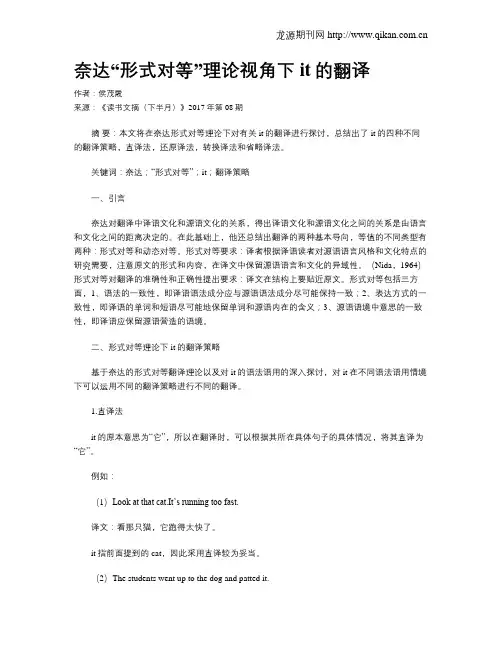
奈达“形式对等”理论视角下it的翻译作者:侯茂霞来源:《读书文摘(下半月)》2017年第08期摘要:本文将在奈达形式对等理论下对有关it的翻译进行探讨,总结出了it的四种不同的翻译策略,直译法,还原译法,转换译法和省略译法。
关键词:奈达;“形式对等”;it;翻译策略一、引言奈达对翻译中译语文化和源语文化的关系,得出译语文化和源语文化之间的关系是由语言和文化之间的距离决定的。
在此基础上,他还总结出翻译的两种基本导向,等值的不同类型有两种:形式对等和动态对等。
形式对等要求:译者根据译语读者对源语语言风格和文化特点的研究需要,注意原文的形式和内容,在译文中保留源语语言和文化的异域性。
(Nida,1964)形式对等对翻译的准确性和正确性提出要求:译文在结构上要贴近原文。
形式对等包括三方面,1、语法的一致性,即译语语法成分应与源语语法成分尽可能保持一致;2、表达方式的一致性,即译语的单词和短语尽可能地保留单词和源语内在的含义;3、源语语境中意思的一致性,即译语应保留源语营造的语境。
二、形式对等理论下it的翻译策略基于奈达的形式对等翻译理论以及对it的语法语用的深入探讨,对it在不同语法语用情境下可以运用不同的翻译策略进行不同的翻译。
1.直译法it的原本意思为“它”,所以在翻译时,可以根据其所在具体句子的具体情况,将其直译为“它”。
例如:(1)Look at that cat.It’s running too fast.译文:看那只猫,它跑得太快了。
it指前面提到的cat,因此采用直译较为妥当。
(2)The students went up to the dog and patted it.译文:学生们走到狗跟前,拍了拍它。
在2句中,it指前面提到的dog,因此也采用直译的方法。
2.还原译法it当用作指示代词指代前面所提到的事物时,有时可以根据翻译句子需要,明确其指代对象,将其指代的具体事物翻译出来。
例如:(1)She could,if she wanted,compel him through a court law to support the child after it was born.译文:如果她愿意,她可以通过法庭强制在孩子出生以后抚养孩子。
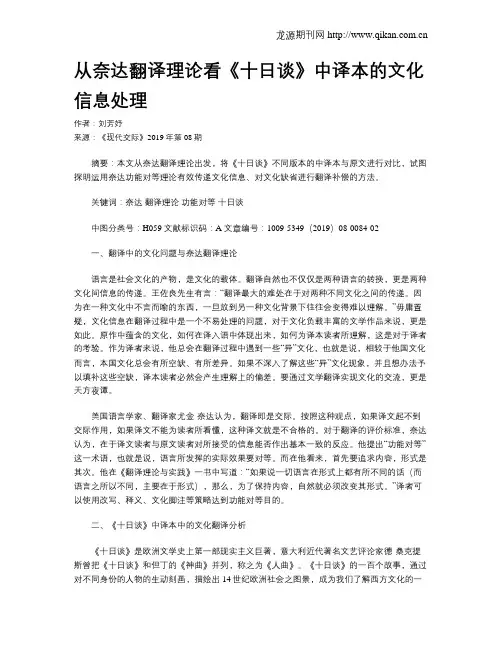
从奈达翻译理论看《十日谈》中译本的文化信息处理作者:刘芳妤来源:《现代交际》2019年第08期摘要:本文从奈达翻译理论出发,将《十日谈》不同版本的中译本与原文进行对比,试图探明运用奈达功能对等理论有效传递文化信息、对文化缺省进行翻译补偿的方法。
关键词:奈达翻译理论功能对等十日谈中图分类号:H059 文献标识码:A 文章编号:1009-5349(2019)08-0084-02一、翻译中的文化问题与奈达翻译理论语言是社会文化的产物,是文化的载体。
翻译自然也不仅仅是两种语言的转换,更是两种文化间信息的传递。
王佐良先生有言:“翻译最大的难处在于对两种不同文化之间的传递。
因为在一种文化中不言而喻的东西,一旦放到另一种文化背景下往往会变得难以理解。
”毋庸置疑,文化信息在翻译过程中是一个不易处理的问题,对于文化负载丰富的文学作品来说,更是如此。
原作中蕴含的文化,如何在译入语中体现出来,如何为译本读者所理解,这是对于译者的考验。
作为译者来说,他总会在翻译过程中遇到一些“异”文化,也就是说,相较于他国文化而言,本国文化总会有所空缺、有所差异。
如果不深入了解这些“异”文化现象,并且想办法予以填补这些空缺,译本读者必然会产生理解上的偏差。
要通过文学翻译实现文化的交流,更是天方夜谭。
美国语言学家、翻译家尤金·奈达认为,翻译即是交际。
按照这种观点,如果译文起不到交际作用,如果译文不能为读者所看懂,这种译文就是不合格的。
对于翻译的评价标准,奈达认为,在于译文读者与原文读者对所接受的信息能否作出基本一致的反应。
他提出“功能对等”这一术语,也就是说,语言所发挥的实际效果要对等。
而在他看来,首先要追求内容,形式是其次。
他在《翻译理论与实践》一书中写道:“如果说一切语言在形式上都有所不同的话(而语言之所以不同,主要在于形式),那么,为了保持内容,自然就必须改变其形式。
”译者可以使用改写、释义、文化脚注等策略达到功能对等目的。
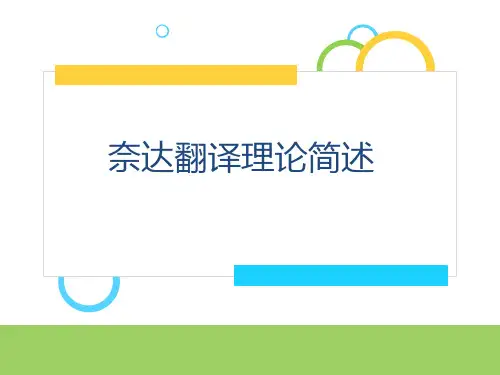

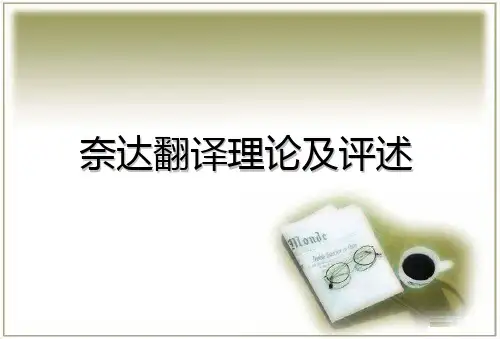
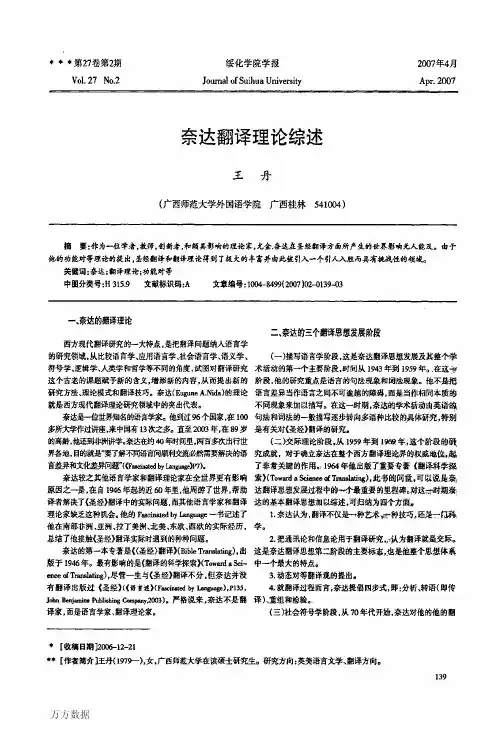
浅谈尤金.奈达功能对等翻译理论摘要:本文对奈达的功能对等理论进行了分析,并通过大量的实例证明对等理论对广告翻译具有的指导意义。
文章从广告的文化内涵和语言结构和两个方面探讨了英汉广告互译中的翻译对等理论的应用问题,对商标翻译中不同的文化因素进行了阐述,并通过大量实例分析如何跨越商标翻译中的文化障碍达到商标翻译的文化等效,更好地将尤金・奈达的功能对等翻译理论应用到翻译实践中去。
关键词:尤金・奈达功能对等翻译理论商标翻译文化等效处理1.引言著名的语言学家、翻译大师尤金・奈达关于翻译的“功能对等”核心理论在翻译界影响深远,是我国较早被引进的理论之一,在中国翻译界的影响较大,也是我国翻译学界评价较多的理论。
当前,全球一体化,多元文化并存,不同的地域社会和历史经历形成了不同的文化造就了人们不同的思维方式、价值观念及风俗习惯等,这些差异给翻译实践带来了很大的难度和障碍。
因此,文化因素在翻译中占有至关重要的作用,要想使翻译作品能够为更广泛的人们所接受,在更为广泛的地域被流传,在翻译实践中就更应该注重翻译的等效策略。
随着经济全球化的发展,世界各地的企业家都力求在全世界市场范围内树立自己的品牌形象,商标翻译质量直接影响商品在广大消费者中的认可程度,影响商品在市场上的竞争力,商标的翻译便成为企业进入世界市场的关键一步。
商标翻译是一种跨文化交际活动,涉及到地域文化、语言规律和审美取向等诸多因素。
企业要想使自己的产品成功地进入到某个国家的市场就必须注重产品商标的翻译质量。
本文通过对几个实例商标翻译的研究探析了文化等效翻译原则在翻译中的应用。
2.等效翻译理论尤金・奈达提出的“等效翻译理论”即在动态对等翻译中译语接受者和译语信息之间的关系应该与源语接受者和原文信息之间的关系基本相同的理论。
因此,在翻译中,根据奈达的理论,译者应以动态对等作为翻译的原则准确地在目的语中再现源语的文化内涵。
与以往的翻译理论相比较,功能对等理论的不同之处在于它将翻译纳入语言学的研究领域的同时,还将文化以及西方文论中的读者反应纳入到翻译研究的领域。
浅析奈达的功能对等翻译理论摘要:奈达的翻译理论是最受中国翻译研究者欢迎的当代西方翻译理论之一。
本文介绍和评述了奈达翻译理论中的核心――“功能对等”理论, 并进一步探讨了“功能对等”理论所遵从的原则和指导意义。
关键词:翻译理论尤金•奈达功能对等一、引言上世纪六十年代,美国著名语言学家、翻译家尤金•奈达提出了一套“以读者的反应为依据的翻译理论”, 在西方翻译学理论体系中树起一面旗帜,一改过去翻译理论只注重原作在译文中的表现情况, 和译文与原文表现对等的翻译观念。
而他的“功能对等”理论自20 世纪80 年代初被介绍到中国以来, 已经成为当代西方理论中被引进的影响最大的理论。
它对一直受忽视的译文读者给予了更多的重视, 尤其是他的核心理论“功能对等”理论, 打破了中国传统翻译中静态分析翻译标准的局面, 提出了开放式的翻译理论原则。
这一理论给中国翻译界带来了新鲜空气,也给译论注入新的血液。
然而奈达的理论对我们的翻译究竟有何理论意义及实践意义呢? 本文将从该理论的起源,实质,对中国翻译理论的影响与指导意义及相关争议等方面来对该理论进行介绍。
二、功能对等论的起源功能对等论在翻译史上是同等效果论的变体。
在历史上第一个提出同等效果论的是英国翻译理论家泰特勒。
1790 年,他在《优秀的翻译》一文,为“优秀的翻译”下了一下定义:“好的翻译是把原作的优点完全移植在译作语言之中,使译语使用者像原语使用者一样,对这种优点能清楚地领悟,并有着同样强烈的感受”。
这就是说优秀的译文应该能够在不同的语言社会里和原作产生同等的效果。
而德国翻译理论家考尔在1896 年的《翻译艺术》一书中称之为“效果相等”。
英国翻译理论家E. V. Rieu 则把这一项要求正式命名为“同等效果原则”。
在中国的译论史上也有不少翻译家及翻译理论家提到过翻译中的等效问题。
马建忠在1894 年提出的“善译”思想中,等效理论就初见端倪。
奈达的“功能对等论”对英汉翻译的指导意义第10卷第1期2011年1月漯河职业技术学院JournalofLuoheV ocationalTechnologyCollegeV o1.10No.1Jan.20l1doi:10.3969/j.issn.1671-7864.2011.01.039奈达的"功能对等论"对英汉翻译的指导意义冉红雨(河南质量工程职业学院,河南平顶山467000)十.夺'々'申'々'夺'+々''々'々.+'+.夺?夺?々?牵'牵'幸'々?+?夺?夺??夺?夺?争?夺??夺?夺?夺?牛?串?夺?专??寺?夺?串?夺?辛-寺?串?幸?夺?摘要:尤金?阿尔伯特?奈达提出了翻译的"对等论",对中西翻译界产生了深远的影响.在功能对等的翻译中,译者着眼于原文的意义和精神,而不拘泥于原文的语言结构.本文主要对功能对等翻译理论对英汉翻译的指导意义以及局限性进行了探讨.关键词:奈达;等效;翻译理论中图分类号:H315.9文献标识码:A文章编号:1671—7864(2011)0l-0094-02 ●?~}-?夺??专??串?々?专?夺??夺?专?夺?夺?夺?夺?牛??夺?夺?夺?专??夺?÷夺??÷?夺?夺??÷??夺...奈达翻译理论中最为人熟悉的一面,就是他的对等翻译观,它摈弃了"文本中心论"的主张,更多关注的是一向受忽视的读者.这在一定程度上解决了长期以来酬译家们相持不下的直译和自由译之争,曾经一度在译沦界备受推崇,但是,近2O年来,也有人在深入研究之后对所谓的"等效'等值"翻译原则直争执不休.为了避免偏见和误解,本文在前人的研究基础之上,系统地阐述和分析了奈达等效翻译理论,同时对其局限性进行了探讨.一,功能对等论的发展历程首位提出等效理论的是英国文艺理论家泰特勒,1790年他在《翻译原理简论》一一文为"好的翻译"下的定义:"好的翻译是把原作的优点完全转移到另一种语言去,使得译文语言国家的人们能够清晰的领悟,强烈的感受,正像使』}j原作语言的人们所领悟,所感受的一样"(Tytler,1978:15—16).随后,在1890年,德网翻译家考尔在《翻译艺术》一书中称这种现象为comparableeffect(效果相等).1931年,中国的革命翻译家瞿秋白提出_r到那个时候最全面的概念:"翻译应该把原文的本意,完全正确地介绍给中国读者,使中罔读者所得到的概念等于英俄德法……读者从原文得来的概念."(金,1998:14).这里明确地提出两种接受者的感受应该相等,这是等效概念的关键.奈达首次提出等效理论是在1964年出版的《翻译科学初探》书中,并将其分为两种不同类型的对等:形式对等和动态对等.因为动态对等有严格的要求,不足那种自山发挥.然而,这一理论引起了一些误解,人们把它理解为仅指某些特殊效果和感染力的东西.奈达本人也意识到"动态对等"只强调译文与原文在内容f:的一致优于形式上的一致,有失偏颇.为了消除人们的误解,使其含义更清楚,后来改称"功能对等"(functionalequivalence).到了90年代,奈达进一步完善了他的理论,为了强调对等的灵活性,提II{了对等的两个层次:最高层次的对等和最低层次的对等.功能对等理论打破了传统的翻译方法(以原文和译文的关系作为衡量翻译正确与否标准的模式),提出了以读者和文章的关系作为衡量翻译正确与否的标准,并且在处理语言转换问题上具有抛开形式看内容,抛开语言差异看读者反应的特点,这是以往的翻译理论所不能及的.二,功能对等论对英汉互译的指导意义奈达在和塔伯合着的《翻译理论与实践》中对翻译的定义:Translationconsistsinreproducinginthereceptorlanguage theclosestnatureequivalentofthesourcelanguagemessage,first intermsofmeaningandsecondintermofstyle(Nida,1969: 12).奈达从功能角度对翻译下的定义有三大优点:首先,它说明了要翻译的东西是什么,很明显,是信息,重在内容,然后才是形式;其次,它表明了由于语言文化上的差异对原语文本与译入语文本只能做到相对的对等;最后,它考虑到了译文的可接受性.下面就其对中英互译的意义做进一步阐述. (一)相对的对等"对等论"自提出之后在很长时间内成了西方翻译理论的核心概念,上个世纪80年代被引进到中国,一直备受争议. 其中,对"等"的理解成为一个关键问题.这里的"equiva—fence"不是绝对的,《牛津英语词典》对"equivalence"的解释是"virtuallythesamething".这个解释的关键之处就是virtu—ally一词,它的意思是"近乎于",并非"完全一样".奈达所采用的"形式对等"和"动态对等"等术语,问接说明了对等只是相对的.在翻译中,译者所寻求的应当是对等语,而不应是同一语.从某种意义上说,也就是再现原语信息,而不强求保持其表达形式.以manandwife为例,汉语"男人"可以表示丈夫(如"他男人是谁?"),"女人"可以表示妻子,(如"他的女人很漂亮"),似乎正与这个英语短语中的两个名词的词义范围相同,但是我们可以用"男人","女人"来翻译它吗?显然不收稿日期:2010—12—23作者简介:冉红雨(1983一),女,河南平顶山人,河南质量工程职业学院助教,硕士在读,研究方向为翻译.第1期冉红雨:奈达的"功能对等论"对英汉翻译的指导意义95能."一对男女"不一定是夫妇,而如果把"Theyarenotmanandwife"译成"他俩不是男人和女人",那就更是不知所云了.因此,在翻译过程中,译者不需要搬用一些僵硬,简单化的公式以求形式对等,而是灵敏地抓住微妙的变化,使这种语言转化过程符合真正的语言规律.在理论上复杂得多的问题,是某些文字所涉及的内容(而不是形式)对于译文读者是难于理解的,其中既有形象化语言中的问题,也有实际事物,然而在什么情况下才可以变动?奈达在和华德合着的新作《从一种语言到另一种语言》提到只有以下五种情况才可以作"形式上的改变":1.直译原意会使意义发生错误.2.借用会构成语义空白,因而可能使读者填入错误意义.3.形式对应会引起严重的意义不明.4.形式对应会产生不为原作者有意安排的歧义表达法.5.形式对应引起译文语法错误,语体不合(Waard&Nida,1986:36—39).这几条规定显然包含现代符号学理论和大量翻译实践经验的结晶,对于翻译理论是一个重要贡献,是翻译工作者在需要变动语义时的一个很好的参考.(二)最切近,最自然的对等由于语言文化的差异,在翻译中取得绝对对等已是不可能的.一个成功的翻译家总是灵活地加以变通,准确地再现原语的精神,追求最切近,最自然的对等,也就是说,使译文最大限度地贴切原文,此外,译文还应该是行文自然,不带翻译腔.如:Inconsequence,I'minclinedtoreservealljudgments,a habitthathasopenedupmanyCUriOUSnaturestomeandalsomademethevictimofnotafewveteranbores. (ScottFitzgerald,TheGreatGatsby)译文一:……也是我成为不少爱唠叨的惹人厌烦的人的受害者.译文二:……也使我饱尝了不少烦人透顶的家伙之苦.这两种译文不能算错,但是渎起来很不自然,带有明显的翻译腔.原因是汉语中的"受害者…'受苦者"跟"爱唠叨的惹人厌烦的人"或"烦人透顶的家伙"之问,并不像英语victim 和bores之间那么明确.在这种情况下,译者可以摆脱victim =受害者,受苦者的影响,将其灵活地加以变通为"……也使不少爱唠叨的人喜欢缠住我不放"之类的话,就比较容易达到更切近原文的意思.此外,"切近""自然"不仅指语言,还指在文化上,思维习惯上行得通.各民族都有自己不同的文化背景,人们的审美习惯,思维方式千差万别.就辞格而言,英汉语之问有相似也有差异.因此,在进行英汉互译时,就必须得考虑到原语中的修辞是否能为译语读者所接受,词汇搭配能否符合对方的习惯和审美特性,进而选择与原文辞格相对应的最切近,最自然的译文表达方式.试看对李白的《静夜思》的两篇译文: w.J.B.Fletcher的译文:TheMoonShinesEverywhereSeeingthe1110013beforemycouchSObrightIthou[ghtboarfrosthadfallenfromthenight OnherclearfaceIgazewithliftedeyesThenhidethemfu11ofYouth'Ssweetmemories赵甄陶的译文:QuietNightThoughtsMoonlightbeforemybed,Coulditbefrostinstead?Headup,1watchthemoon;Headdown,Ithinkofhome.在这两篇译文中,赵译更容易让人接受,简洁明了,风格和诗中情境是协调的."Headup,…Headdown…"这个译法从内容到形式都和原文一致,达到了最切近,最自然的对等. 译文一,诗句本身很美,但文体或意境与全诗不协调,把"明月"译成"Herclearface","望明月"译成"凝视着她的明亮的脸庞",虽有诗意,但浪漫色彩过重,而且与乡思毫不相干,不能像原文一样能触动读者的感情.因此,不管是语内交际(intralingualtranslation)还是语际交际(interlingualtranslation),两篇不同的话语之间肯定有一定的差别,不可能绝对对等.如上例所描述,不同的语音语法词语等表达形式的差异并不影响相同的表达功能,译者的主要任务就是在语言之间,文化之间研究这种差异,在意义和文体上找出最佳对等语言关系,使译文最大限度地从内容和形式七贴近原文.三,奈达"对等论"的不足之处奈达是一个硕果累累的翻译理论家,然而他的理论远非尽善尽美,也存在着一定的不足之处.首先,长期从事《圣经》翻译和研究的奈达认为上帝的信息是一种普遍真理,译文应使"万国子民"易于理解和接受.但是对原文文本中审美信息的传递没有给予足够的重视.如: "石室诗士施氏,嗜狮,誓食十狮.氏时时适市视狮,十时,适十狮适市.是时,适施氏适市.氏视是十狮,恃矢势,使是十狮逝世.氏拾是十狮尸,适石室,石室湿,氏使侍拭石室.石室拭,氏始试食是十狮尸.食时,始识是十狮尸,实十石狮尸.试释是事."赵元任先生这篇精妙绝伦的文章《施氏食狮史》含有中国特有的同音导意词,如何将其原汁原味地译成其他语言,尤其它无法转换的音律变化和语体,恐怕很难达到等值.其次,奈达特别重视译文读者对译文信息的反应.然而,由于读者的信仰追求,文化背景,教育程度,兴趣爱好,价值取向各不相同,对同一作品就持有不同的态度和评判标准,全民读者是没有的.而且,这一理论低估了读者的求真心理,读者还是愿意在译文中感受当地的风土人情习俗时尚的.但是当他们看到译文表述与本国社会相差无几时,他们就会产生怀疑.综上所述,等效论有实用性的一面,也有其不可避免的局限性.但奈达以现代语言学,社会语言学,社会符号学,交际学理论和信息论的方法研究翻译理论和翻译实践中的问题,是对翻译理论的重大突破.同时,我们也应当看到其理论的缺陷,我们所作的就是"吸取精华",在此基础之上,进一步研究,学习,在实践中发现更多有价值的东西,进一步完善我们的翻译理论.参考文献:【1]金陡.等效翻译探索[M].北京:中国对外翻译出版公司, 1998.[2]谭载喜.新编奈达论翻译[M].北京:中国对外翻译出版公司, 1999.[3]孙致礼.再谈文学翻译的策略问题[J].中国翻译,2003,(1): 48—51.[4]贾秀海.奈达的功能对等论fJ].东北财经大学,2008,(4):92~94.[5]Waard,Jande&Nida,EugeneA,FromOneLanguageToAnother, Nashville,Tenn,ThomasNelsonPublishers,1986:36—39.[6]AlexanderFrasterTytler,EssayonthePrinciplesofTranslation Amsterdam,JohnBenjaminsB.V..1978:15—16.[7]Nida,EugeneA.&Taber,Chades.TheTheoryandPracticeoftrans—lmion.ShanghaiForeignLanguageEducationPress,2004:12[责任编辑孟蕴华]。
龙源期刊网 http://www.qikan.com.cn 奈达翻译理论下英文短篇小说翻译策略研究 作者:师坛 来源:《文学教育下半月》2018年第04期
内容摘要:短篇小说翻译是英文文学作品翻译的重要组成部分。在翻译英文短篇小说的过程当中,译者应准确表达原文内容,并再现原文风格、人物特征等,这样才能更好地展现原文作品。而奈达翻译理论则为满足英文短篇小说翻译的这一要求提供了理论指导。本文简单阐述了英文短篇小说翻译特征及奈达翻译理论,并从人物语言、修辞及长句等三方面的翻译探讨了英文短篇小说的翻译策略,以为同行业工作者提供若干建议。
关键词:奈达翻译理论 短篇小说 翻译策略 小说翻译要求译者可深刻理解原文,并能利用恰当的目的语来再现原文的艺术风格,使读者可获得类似于原文的阅读感受,这恰好与奈达翻译理论的核心思想相符。奈达翻译理论认为,翻译不只是将文本自一种语言转换为另一种语言,而是要求译文可让译文读者通过阅读译文产生与原文读者相似的反应。将奈达翻译理论应用于英文短篇小说的翻译当中,必然有利于提高小说的翻译质量和水平。
一.英文短篇小说翻译与奈达翻译理论概述 1.英文短篇小说翻译特征 好的译文不仅要求忠实于原文内容,而且还要求将原文作品风格再现。对于英文短篇小说的翻译,其效果的评价重在是否将原文风格再现,这也是多数译者不断努力追寻的目标。泰特勒翻译三原则中的第二原则即为“译文风格与笔调需同于原文”,奈达在定义翻译时也明确指出,翻译,即利用最贴近、自然的译入语来再现原文的内容及风格[1]。由此可以看出,对于英文短篇小说的翻译,原文作品风格的再现极为关键。不同民族的文化语言虽存在较大差异,但却也存在类似的表达,英文短篇小说的翻译即是找到不同语言之间可实现类似表达的过程,翻译的过程当中虽可能不完美,但重在再现作品的整体风格。
2.奈达翻译理论 奈达翻译理论是由世界翻译理论家尤金·A·奈达所提出的。奈达于1964年首次提出“形式对等”和“动态对等”两个概念;1969年,奈达正式定义了“动态对等”的概念,指出动态对等即译文读者可通过阅读译文获取基本同与原文读者阅读原文的反应,即译文与原文可实现自然对等;2004年,为消除人们对于“动态”一词的误解,奈达提出了“功能”一词,并改动态对等理论为功能对等理论,其在书中指明,翻译可不受原语语言形式的制约,在综合考虑读者感受的前提下,保证译文与原文在形式及内容上的对等,从而翻译出最贴切于原文的译文。由此可以看龙源期刊网 http://www.qikan.com.cn 出,奈达翻译理论的重点在于译文是否可让读者获取与原文读者阅读原文基本相同的感受方面,而并不强调完全移植于原文。
20世纪90年代,奈达进一步完善功能对等理论,在充分考虑到不同文化语言之间所存在的差异性较大的基础上,于《语言、文化、翻译》当中将翻译的功能对等分为两个层次,最高及最低层次,其中最高层次是指通过阅读和分析译文,读者可获取基本同于原文读者的感受。此层次是译文最想达到的对文境界,但此层次至今为止仍停留在理论层面而无法真正付诸于实践当中,尤其是译文与原文之间语言存在较大差异时,最高层次的对等极难实现。功能对等的最低层次是指读者在阅读译文后可对原文读者感受进行理解。这是翻译必须达到的最低标准,若未达到,说明此译文的翻译并未合格。就翻译的实质而言,其就是一个寻找译文与原文能尽量贴近的过程,从而使译文读者能够得到与原文读者基本相同的反应。
二.奈达翻译理论下英文短篇小说的翻译策略 1.人物语言的翻译 语言,即指小说人物之间的对话及独白,可体现人物性格,是刻画人物个性的重要手段。语言即心声,通过语言,可了解人物的身份、性格、心理状态等[2]。英文短篇小说中的人物具其自身性格特征,在进行翻译时,为避免出现千人一面的现象,更好地再现作品的风格,同时遵循奈达翻译理论中的功能对等,就必须全面考虑原文人物的语言色彩、主体等级、语言表达方式等,尽量展现原文人物中的语言特征。在此,可采取以下策略:
第一,模仿人物的口吻。如凯瑟琳·曼斯菲尔德所著《在海湾》中当洛蒂问她的表哥皮普为什么要往里倒水的时候,皮普是这样回答的:“Oh,that’s moisten it,”,“to make the work a bit easier.Keep it up,Rags.”原文句中的“moisten”和“work”,本意为“弄湿”、“工作”,在进行翻译时,考虑到皮普和拉格斯的年龄大于洛蒂,俩人较洛蒂也更加成熟,因此,选择了较高语级的“润滑”和“工程”,这样非常符合人物的说话口吻。因此,译文翻译为:“哦,这是要润滑,”,“这样可以让工程更容易点。继续干,拉格斯。” 这样翻译是对人物说话口吻的模仿,很好地再现了原文中人物的性格与身份。
第二,利用谐音模拟原文。《在海湾》的字数虽不多,但对于人物的刻画利用细节描写展现得非常形象。如“A ninseck must be an animal,”she said stoutly.此句中的“ninseck”其实是利用讹音来模仿小女孩的声音,展现了小女孩的活泼可爱,在翻译时,也可利用汉语中部分地区可能很难区分“n”、“l”、“s”、“sh”等音的特征,利用谐音直接将“ninseck”翻译为“昆丛”,整句翻译成“‘昆丛也是动物,’她坚决地说道。” 以展现原文的效果。
第三,加注说明。《在海湾》中有一句: she didn’t care twopence about her house and called the servant Gladys”Glad-eyes”.句中的“Gladys”和“Glad-eyes”为谐音,但汉语当中难以找到相应龙源期刊网 http://www.qikan.com.cn 的谐音,若依原文形式进行翻译,就极易引起读者的误解,此时,就可改变某些文本或是保留字面翻译,但同时应加注相应说明,以免引起误解。
2.修辞的翻译 同汉语文学作品一样,英文短篇小说当中也会有很多修辞手法的应用,以使作品更加形象、具体,体现作品风格。中英语言虽有很多相对应的修辞手法,但在实际翻译当中,若遇特殊情况,译者还需进行灵活处理。具体地,可采取以下策略:
第一,保留修辞手法,保证内容、形式对等。如《在海湾》中,为表现小女孩们的欢乐与活泼,在小女孩们冲进牧场的时候,原文中用了“like chickens let out of a coop”来形容冲进牧场的动态画面,在进行翻译时,可保留这种比喻的修辞手法,但在形式及内容方面,可保持与原文对等,翻译成“小女孩们冲进牧场,就像一群出了笼的小鸡一样。”很好地体现了原文的修辞风格。
第二,舍弃修辞,采取意译法。如“The others glanced at one another like conspirators.”句中的“conspirators”原意为“同谋”,但若直接翻译成“同谋”,整个句子就会显得非常别扭。此时,就可结合上下文,前文说到洛蒂因为受到其他小孩的嘲笑而说不想玩了,也知道洛蒂马上就要哭了,于是就有“The others glanced at one another like conspirators.”意在说明,大家相互看了一眼,都知道洛蒂快要哭了,在进行翻译时,就可依原文的意思将其翻译成“心照不宣”,这样既表达了原文意思,又符合汉语的表达方式,使文章显得自然。
3.长句的翻译 句子可表达一节完整的思想,但长句的结构相对复杂,且含各类分句套,翻译难度明显加大。为能尽量贴近原文风格及原作者的写作习惯,在进行翻译时,应尽量保留原有的语言结构。但中英语言习惯存在较大差异,为能使译文显得自然、贴切,就需掌握一定翻译技巧[3]。具体地,在实际翻译当中,可采取以下措施:
第一,拆分翻译。如“The few streets rising one above the other were irregular in their tortuous effort to cuddle up to the houses that were built haphazard and wide apart.”原文仅一个句子,但句子结构非常复杂,若依原文直译,就会显得译文啰嗦、冗长,为此,可将原文进行拆分,将其变为两个短句,使其与中文表达习惯相符,翻译为“仅有的几条小路迂回地盘旋于山腰,几处距离较远的居所零星、毫无拎地分布着。”这样整个句子显得非常自然,也与原文所要表达的意思贴近。
第二,增译或减译。为提高译文吸引力,在进行翻译时,可适当增加一些词汇,使译文更加地道、通顺,也与中文表达习惯相符。如“The spring was nothing new to him,nor was its sounds,its perfumes,its colors; nor was its tender and caressing breath.”原文中连用四个“its…”龙源期刊网 http://www.qikan.com.cn 来表达“he”所感受到的春天的各种气息,在进行翻译时,可依整句含义适当增加一些词语,将其翻译为“春天对他来说并不新奇,那里有熟悉的声音,熟悉的香气,熟悉的色彩;连那温柔与爱抚的气息也是他所熟悉的。”这样使译文也能体现出如原文一般的结构形式,实现功能对等。
三.结语 不可否认的是,奈达翻译理论也曾受人质疑,其发展至今仍存在一定缺陷,但同样不可忽视的是,奈达翻译理论确实为英文短篇小说的翻译提供了新的思路和方向,使得译文显得自然、贴切,让译文读者能够获得基本同于原文读者的感受,有效提高了翻译的质量及水平。小说具较高的美学价值,译者需具备很高的文字功底,熟练掌握翻译技巧,才能更好地再现原文内容和风格。
参考文献 [1]刘倩.“功能对等”翻译理论观照下芥川作品汉译比较研究[D].中国海洋大学,2014. [2]郑莲花.基于功能对等理论的《欧·亨利短篇小说》常用修辞手法的翻译研究[D].福建师范大学,2014.
[3]王宇昕.功能对等理论下的复合句翻译[D].南京大学,2017. (作者单位:郑州大学西亚斯国际学院)